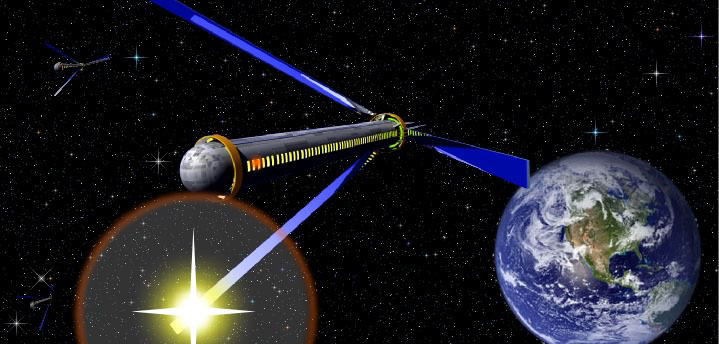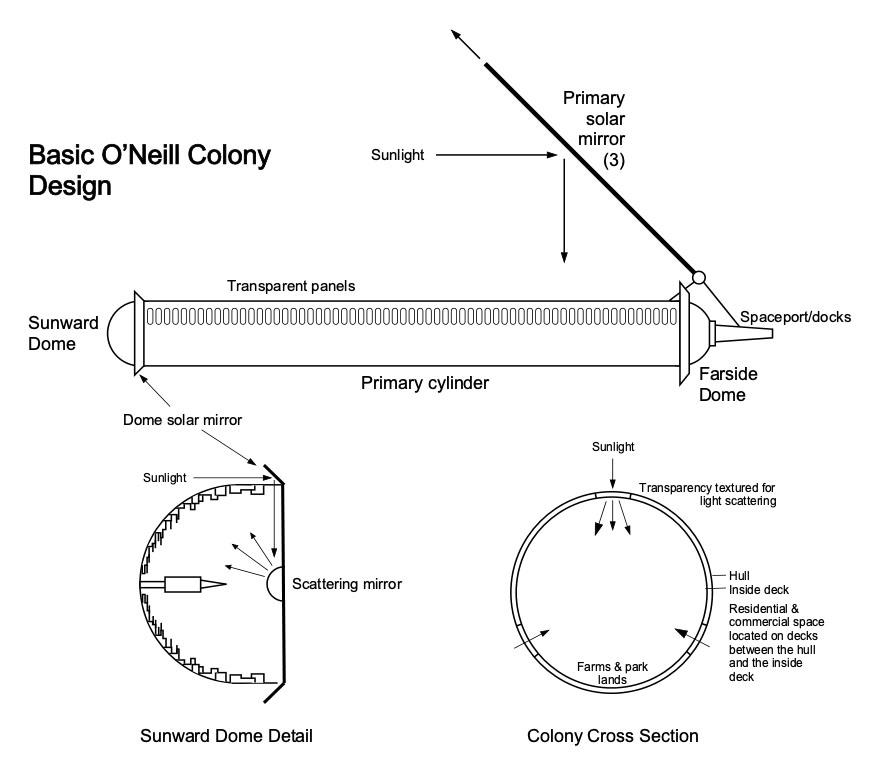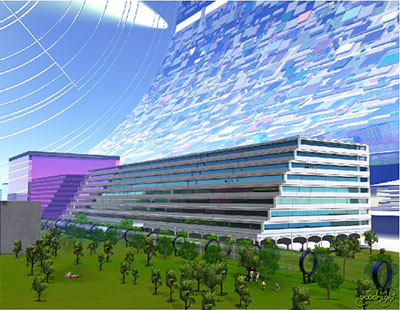Hello—
As I mentioned at the start of the recent DUTBU archive, I’m going to be getting back to my blog series on the history of the UOC. Since it’s been quite some time since I last posted, I wanted to begin with a short recap of “the story so far.” But as I sat down to write that, I found myself delving into more of the backstory about the origin of the Colonies themselves, prior to the independence movement that began this series. So I’ve divided the planned Recap post in two. Today, it’s “deep background” on the Colonies, and next time I’ll recap the story itself. After that, my plan is to get back to a weekly schedule of updates as the History of the Offworld Colonies continues.
Building the Colonies
At the start of the 22nd Century the Earth and its then-small offworld population lived under a single government, the Terran Federation, which emerged from the wreckage of what became known as the Unification War. The war is somewhat misnamed, since unification was not the goal of either side in that conflict. It emerged instead as a consequence of the costly victory of the democratic allies and the rebuilding efforts that followed. The actual causes and justifications for the war remained highly controversial among both historians and political factions; but by the dawn of the new Century all agreed that the unification which came out of it was its one unqualified benefit.
The late 21st and early 22nd Centuries saw a period of great prosperity and economic expansion. This coincided with a shift of Earth’s industrial base off the planet and into an increasing number of offworld factory platforms which proliferated in Earth and Lunar orbit as well as (when the standard orbital tracks began to get overcrowded) the L4 and L5 points of the Earth-Moon system. The move offworld was driven by both economic and environmental benefits: increasing technology had made spaceflight steadily cheaper and safer, and allowed industries to take advantage of zero-G engineering. At the same time, the shift reduced the impact of pollutants on Earth’s ecosystems. The benefits, combined with others following on from unification, contributed to the prosperity of the time.
However, the offworld shift of industry also brought new problems, the political status of the growing offworld population chief among them. A string of scandals involving governance of the offworld “company towns” led to a reform movement that aimed to normalize the status of the offworld population. After many twists and turns of political debate, this movement finally took the form of constructing a series of massive space platforms, called the O’Neill Colonies after a 20th century scientist who had speculated about similar designs, which were to assume the legal status of states within the Continental Directorates of the Terran Federation
Each Colony was to be funded by one of the Directorates and would have the status of a state within its parent government. As states, the Colonies would then exercise legal jurisdiction over the smaller industrial platforms, based in part on orbital location but many assigned arbitrarily to balance the numbers belonging to each Colony.
The 22nd Century’s prosperity created an age of grandiose projects both Earthbound and offworld, and the O’Neill Colonies were perhaps the greatest statement of the era’s extravagance. Experience with the smaller offworld outposts had shown that self-sustaining lifesystems, based on biological recycling, were more stable the larger the platform and the more diverse its biosystems. For that reason, and also to accommodate future population growth, the basic Colony design was massive, far in excess of immediate need.
The basic design would be the same across all Colonies, though variations were introduced as technology advanced over the decades of construction. Each Colony would have the form of a cylinder, between thirty and fifty kilometers in length and four to six in diameter. They would rotate on their long axis to supply gravity. Solar cells supplied electrical power and angled mirrors directed additional sunlight through transparent panels to light the interiors. Networks of algae tanks provided most lifesystem recycling via photosynthesis.
Industrial activity continued to belong primarily to the separate, smaller factory platforms. However most Colonies had some minor industrial capacity as well, clustered mostly in their “Farside domes” on the end of the Colony away from the sun, where spaceports and docking facilities were also located. Residential and commercial space occupied the shell of the cylinder, between the outer hull and the inmost deck, while the open space inside was reserved for farms and parklands. Several Colonies included an above-decks residential district, such as Star City’s “Midway,” but these were small compared to the open ground.
Since species diversity contributed to stability in biosystems, the Colonies were careful to host a wide variety of plants and animals. The interiors set aside large areas for botanical and zoological gardens stocked with species native to each Colony’s sponsor continent, as well as farms and recreational parks.
The O’Neill Colonies were constructed over the course of fifty years in the first half of the 22nd Century. The work began with an extensive refit of two existing “cities,” Aurora and Prometheus, by the North American and UK Commonwealth directorates respectively. Aurora assumed legal status as a state within the North American directorate on October 9, 2113. Prometheus joined the UK Commonwealth on February 1, 2117. The first Colony constructed specifically for the O’Neill project was Delta, constructed by the Asian directorate and legally becoming a state on October 31, 2132. Construction continued until the twenty-third and last O’Neill Colony, Marta (South American directorate) became a state on October 14, 2160. Three years later, on April 8, 2163, an act of the Terran Parliament reclassified Copernicus, the major city on the Lunar surface, as the twenty-fourth Colony, with jurisdiction over all Lunar outposts.

Star City, 18th Colony completed and the eventual capitol of the UOC, imaged in 2150 shortly after completion.
As the 2160s gave way to the seventies, none of the Colonies had achieved complete sustainability in their lifesystems. The buildup of populations, from the microscopic algae of the lifesystem tanks to the largest animals in the zoological parks, followed a carefully planned and gradual buildup to avoid throwing the systems into chaotic fluctuations. It was not expected that any would become self-sustaining until the end of the century. Until then, they required ongoing resupply from Earth, though the amounts steadily decreased as the buildup continued.
In the 2170s, a political movement began among the offworld population to reclassify the Colonies into their own “Continental” Directorate, separating from the sponsor directorates that had built them. The argument was that they all had interests and governing requirements more in common with each other than they had with Earthbound states of their directorates. This movement was highly controversial, since the Continental Directorates had expended a great deal of resources in building the Colonies and felt entitled to the tax revenue they generated. Nevertheless the idea continued to gain popularity among the offworld population.
While all this was going on, a natural phenomenon began that would eventually turn the prosperous 22nd Century upside down.
The Sun had always been slightly variable, both chaotically and in the regular sunspot cycle. But starting in the second half of the century, astronomers gradually became aware of an increase in its fluctuations beyond any previously recorded. A cycle of increasing and decreasing brightness with a period of several months began, with wide variation in both magnitude and duration, along with faint but detectable random flickers on the scale of a few minutes to a few seconds. At first detectable only in astronomical observations, over a few years these fluctuations began to impact Earth’s ecosystems. Weather patterns shifted in often destructive ways, while a few month’s drop in sunlight during a growing season could reduce the yield or cause outright failure of crops across a whole hemisphere. The impacts came on gradually, but by the end of the seventies the vaunted prosperity of the 22nd Century was beginning to crumble.
The Colonies, with lifesystems already carefully engineered to absorb chaotic fluctuations over decades of a slow growth toward stability, were better able to handle these fluctuations. As food prices rose on the planet, and the costs radiated outward throughout the economy, the Colonies remained prosperous. Planetbound populations noticed, and an undercurrent of resentment began.
In 2178 a new political party, calling itself Born To The Earth, began to gain traction by claiming that it was the supply of resources to the offworld population, rather than the Sun’s fluctuations, which had caused the problems on Earth. They claimed that Earth would have naturally absorbed the Sun’s variations if not for the drain of resources off the planet. Scientists saw no merit to this claim but populations facing hardship were eager for a scapegoat. Even so, though the Born to the Earth party gained a few seats in the Terran parliament in the 2180 elections, it remained a fringe group that few took seriously.
In the election of 2182, the Colonies managed to get an amendment to the Terran charter onto the ballot, to reorganize the Colonies into an “Offworld Continent.” The measure was opposed by every existing Continental Directorate. In the same election, Born to the Earth nominated Alexander Monroe for the presidency of the Federation. In October of 2182, Monroe was polling at twenty percent— higher than anyone had expected but still with no realistic chance of winning.
That would change on October 24, 2182.
To Be Continued



